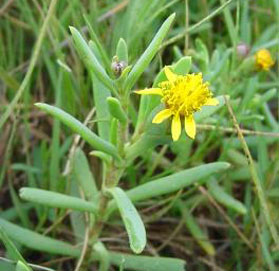Salty Susan
Jaumea carnosa
Salty Susan is a California native plant, a halophyte, and a member of the Sunflower Family. Other common names are saltmarsh daisy, marsh jaumea, and fleshy jaumea. It is a perennial succulent that forms a creeping ground cover. It resembles pickleweed (Salicornia virginica) but its stems do not have joints and it has visible leaves.

Credit: M.Charter. Used with permission.
SPECIES IN DETAIL
Salty Susan
Jaumea carnosa
CONSERVATION STATUS: Safe for Now
CLIMATE CHANGE: Not Applicable
At the Aquarium
Our plants which are located in the Shorebird Sanctuary were donated by the Stewards of the Los Cerritos Wetlands located in Long Beach, California.
Geographic Distribution
Coastal California north to British Columbia, Canada and south to Baja California, Mexico.
Habitat
These plants grow at the margins of coastal saltmarshes and tidal flats where there is protection from wave action.
Physical Characteristics
Salty Susan’s blue-green leaves are shiny, smooth, linear, and fleshy. They grow opposite each other on a weak stem. Flowering occurs from May to October. A small, single yellow daisy-like flower forms at the end of the stem.
Size
The stem is about 30 cm (12 in) tall. Flowers are 6-7mm (0.24-0.28 in) wide. The brown fruit formed is 2-3 mm (0.08-0.12 in) long.
Diet
Photosynthesis is the source of nutrition for these plants.
Reproduction
Salty Susan reproduces sexually and asexually. Its primary method is by vegetative propagation in which new clones are formed from its extensive rhizomes. This plant is dioecious, that is, male and female flowers are separate individuals. Insects that feed on the plant’s pollen and nectar are the vectors that transfer the pollen from the male’s stamen to the female’s stigma where cross-fertilization takes place.
Adaptation
These salt excluders use a filtration system to keep salt from entering their tissues. The root system acts as a barrier to filter out salt while taking in fresh water. The plants tolerate brackish and salty water and alkaline soil.
Conservation
Like all plants that use estuarine ecosystems for habitats, Salty Susan is affected by the replacement of wetlands by residential, commercial, and industrial development and by urban runoff that pollutes these areas.
SPECIES IN DETAIL | Print full entry
Salty Susan
Jaumea carnosa
CONSERVATION STATUS: Safe for Now
CLIMATE CHANGE: Not Applicable
Our plants which are located in the Shorebird Sanctuary were donated by the Stewards of the Los Cerritos Wetlands located in Long Beach, California.
Coastal California north to British Columbia, Canada and south to Baja California, Mexico.
These plants grow at the margins of coastal saltmarshes and tidal flats where there is protection from wave action.
Salty Susan’s blue-green leaves are shiny, smooth, linear, and fleshy. They grow opposite each other on a weak stem. Flowering occurs from May to October. A small, single yellow daisy-like flower forms at the end of the stem.
The stem is about 30 cm (12 in) tall. Flowers are 6-7mm (0.24-0.28 in) wide. The brown fruit formed is 2-3 mm (0.08-0.12 in) long.
Photosynthesis is the source of nutrition for these plants.
Salty Susan reproduces sexually and asexually. Its primary method is by vegetative propagation in which new clones are formed from its extensive rhizomes. This plant is dioecious, that is, male and female flowers are separate individuals. Insects that feed on the plant’s pollen and nectar are the vectors that transfer the pollen from the male’s stamen to the female’s stigma where cross-fertilization takes place.
These salt excluders use a filtration system to keep salt from entering their tissues. The root system acts as a barrier to filter out salt while taking in fresh water. The plants tolerate brackish and salty water and alkaline soil.
Like all plants that use estuarine ecosystems for habitats, Salty Susan is affected by the replacement of wetlands by residential, commercial, and industrial development and by urban runoff that pollutes these areas.

